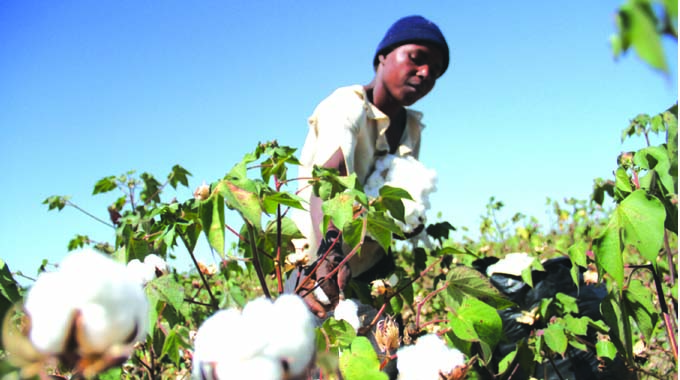New cotton price brings back cheers to growers

Business Reporter
The new producer price for cotton has brought back the smiles on the face of the farmers who faced viability issues over the past two seasons due to the negative impact of inflation on delayed payments and less attractive prices for the “white gold”.
Last week, the Government announced the new cotton producer price for this year, consisting of US$0,30 plus $32 per kilogramme.
Before the latest upward review, the Government, through the Agricultural Marketing Authority (AMA), had set the pre-producer price for 2022 at $111 per kg for the crop funded by private companies and $63,23 for cotton produced under State-assisted farming programmes, the Presidential Free Inputs Scheme and an additional US$30 per 250 kg bale.
Farmers contracted by the Government, through the Cotton Company of Zimbabwe in Gokwe South district, one of the largest cotton growing regions in the country, could not hide their joy after fully paying for the support they received.
Cottco supports about 85 percent of the cotton farmers.
“When the word reached us that we will be paid US dollars (part payment), nobody believed this,” farmer Clopas Chisina said.
“But we are also happy that we have been fully paid. . . US dollar cash and RTGS in our mobile accounts. It is something that we never expected.”
Farmer Sarudzai Makotore said the “good price” would motivate many growers to plant bigger hectarage next season.
“The appetite for growing cotton has been waning because of the payment challenges. But now we are geared to go back to the fields and plant even bigger hectares.”
Farmer coordinator Nevson Masocha said many people were already inquiring about registering for the next cropping season.
“I have been contacted by so many people wanting to register for next season. People are confident and this will certainly boost national production,” said Mr Masocha.
Another farmer Stabile Singele said the US dollar payments would help them to buy household goods, farm implements and livestock.
After the announcement of the new producer price, an emergency meeting was held between the cotton merchants and AMA when some cotton firms indicated they were unable to pay the US dollar component.
An official with Cotton Ginners Association said “concerns have been raised with AMA, which has engaged the Ministry (of Lands, Agriculture, Fisheries, Water and Rural Development),” adding “we are hoping to get the feedback by soon.
Cotton Producers and Marketers Association chairman Stewart Mubonderi said the farmers were looking forward to being paid the price announced by the Government earlier this month.
“Those (merchants) facing the challenges should engage the authorities for help,” said Mr Mubonderi.
“But we are so happy that Cottco is paying and as farmers we are happy. We urge all farmers to deliver their cotton so that ginning can start. We also encourage farmers to desist from the practice of side marketing so that we can have an orderly marketing season.”
Two seasons ago, many farmers had to endure the pain of failing to get the full value of their commodity due to delayed payments after the Treasury delayed releasing the subsidy funds.
Some farmers are yet to be paid while others got their outstanding payments eight months after delivering their cotton.
During the 2020 marketing season, the merchants used household goods, farm implements and groceries as a form of payment.
Cotton output is expected to decline by 30 percent this year to 116 000 tonnes, according to official figures from Agritex. However, the yield would be higher than initial estimates after late rains salvaged some of the crop.
The cotton crop suffered two major setbacks — the late-onset of the rainy season and a very long dry spell experienced in most cotton-growing regions during mid-season.
However, unusually heavy rains in March through April this year undid much of the damage that had been caused by the mid-season dry spell.
Initially, the industry had projected that production would drop to 92 000 tonnes.
At its peak, Zimbabwe produced 352 000 tonnes.
Zimbabwe’s cotton season runs in two phases: planting between October and January and a harvesting and marketing phase that normally runs from May to September.










Comments